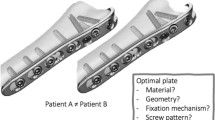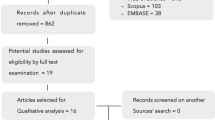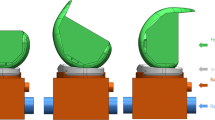Abstract
The biomechanical behavior of implant thread plays an important role on stresses at implant-bone interface. Information about the effect of different thread profiles upon the bone stresses is limited. The purpose of this study was to evaluate the effects of different implant thread designs on stress distribution characteristics at supporting structures. In this study, three-dimensional (3D) finite element (FE) stress-analysis method was used. Four types of 3D mathematical models simulating four different thread-form configurations for a solid screw implant was prepared with supporting bone structure. V-thread (1), buttress (2), reverse buttress (3), and square thread designs were simulated. A 100-N static axial occlusal load was applied to occlusal surface of abutment to calculate the stress distributions. Solidworks/Cosmosworks structural analysis programs were used for FE modeling/analysis. The analysis of the von Mises stress values revealed that maximum stress concentrations were located at loading areas of implant abutments and cervical cortical bone regions for all models. Stress concentration at cortical bone (18.3 MPa) was higher than spongious bone (13.3 MPa), and concentration of first thread (18 MPa) was higher than other threads (13.3 MPa). It was seen that, while the von Mises stress distribution patterns at different implant thread models were similar, the concentration of compressive stresses were different. The present study showed that the use of different thread form designs did not affect the von Mises concentration at supporting bone structure. However, the compressive stress concentrations differ by various thread profiles.






Similar content being viewed by others
References
Beer FP, DeWolf JT, Johnston ER (2005) Mechanics of materials, 4th edn. McGraw-Hill International, Singapore, pp 360–378
Brunski JB (1999) In vivo bone response to biomechanical loading at the bone/dental–implant interface. Adv Dent Res 13:99
Chen J, Xu L (1994) A finite element analysis of the human temporomandibular joint. J Biomech Eng 116:401–407
Chun HJ, Cheong SY, Han JH, Heo SJ, Chung JP, Rhyu IC, Choi YC, Baik HK, Ku Y, Kim MH (2002) Evaluation of design parameters of osseointegrated dental implants using finite element analysis. J Oral Rehabil 29:565–574
Cook SD, Klawitter JJ, Weinstein AM (1982) A model for the implant-bone interface characteristics of porous dental implants. J Dent Res 61:1006–1009
Cruz M, Wassall T, Toledo EM, Barra LP, Lemonge AC (2003) Three-dimensional finite element stress analysis of a cuneiform-geometry implant. Int J Oral Maxillofac Implants 18:675–684
Geng JP, Ma XX (1995) A differential mathematical model to evaluate side-surface of an Archimede implant. Shanghai Shengwu Gongcheng Yixue 50:19
Geng JP, Ma QS, XU W, Tan KBC, Liu GR (2004) Finite element analysis of four thread-form configurations in a stepped screw implant. J Oral Rehabil 31:233–239
Hansson S, Werke M (2003) The implant thread as a retention element in cortical bone: the effect of thread size and thread profile: a finite element study. J Biomech 36:1247–1258
Ivanoff CH, Grönhahl K, Sennerby L, Bergström C, Lekholm U (1999) Influence of variations in implant diameters: a 3- to 5-year retrospective clinical report. Int J Oral Maxillofac Implants 14:173–180
Kong L, Hu K, Li D, Song Y, Yang J, Wu Z, Liu B (2008) Evaluation of the cylinder implant thread height and width: a 3-dimensional finite element analysis. Int J Oral Maxillofac Implants 23:65–74
Misch CE (2005) Dental implant prosthetics. Mosby, St Louis, pp 322–347
Pegoretti A, Fambri L, Zappini G, Bianchetti M (2002) Finite element analysis of a glass fibre reinforced composite endodontic post. Biomaterials 23:2667–2682
Pierrisnard L, Bohin F, Renault P, Barquins M (2002) Corono-radicular reconstruction of pulpless teeth: a mechanical study using finite element analysis. J Prosthet Dent 88:442–448
Rieger MR, Adams WK, Kinzel GL (1990) Finite element survey of eleven endosseous implants. J Prosthet Dent 63:457
Sevimay M, Usumez A, Eskitascioglu G (2005) The influence of various occlusal materials on stresses transferred to implant-supported prostheses and supporting bone: a three-dimensional finite-element study. J Biomed Mater Res B Appl Biomater 73:140–147
Singley JE, Mischke CR (1989) Mechanical engineering design, 5th edn. McGraw-Hill, New York, pp 123–157
Timoshenko S, Young DH (1968) Elements of strength of materials, 5th edn. Wadsworth, Florence, p 377
Ugural AC, Fenster SK (2003) Advanced strength and applied elasticity, 4th edn. Prentice-Hall, New York, pp 155–157
Valen M (1983) The relationship between endosteal implant design and function: maximum stress distribution with computerformed three-dimensional Flexi-cup blades. J Oral Implantol 11:49
Valen M, Locante WM (2000) LaminOss immediate-load implants: 1. Introducing osteocompression in dentistry. J Oral Implantol 26:177
Van Oosterwyck H, Duyck J, Vander S, Van der Perre G, De Cooman M, Lievens S, Puers R, Naert I (1998) The influence of bone mechanical properties and implant fixation upon bone loading around oral implants. Clin Oral Implants Res 9:407
Weinstein AM, Klawitter JJ, Cook SD (1980) Implant-bone interface characteristic of bioglass dental implants. J Biomed Mater Res 14:23–29
Wiskott HW, Belser UC (1999) Lack of integration of smooth titanium surfaces: a working hypothesis based on strains generated in the surrounding bone. Clin Oral Implants Res 10:429–444
Yang HS, Lang LA, Molina A, Felton DA (2001) The effects of dowel design and load direction on dowel-and-core restorations. J Prosthet Dent 85:558–567
Conflict of interest
This study is funded by the Research Projects Counsil of the University of Selcuk. The authors declare that they have no financial, professional, or other personal interest that could influence the position presented in the paper.
Author information
Authors and Affiliations
Corresponding author
Rights and permissions
About this article
Cite this article
Eraslan, O., İnan, Ö. The effect of thread design on stress distribution in a solid screw implant: a 3D finite element analysis. Clin Oral Invest 14, 411–416 (2010). https://doi.org/10.1007/s00784-009-0305-1
Received:
Accepted:
Published:
Issue Date:
DOI: https://doi.org/10.1007/s00784-009-0305-1




